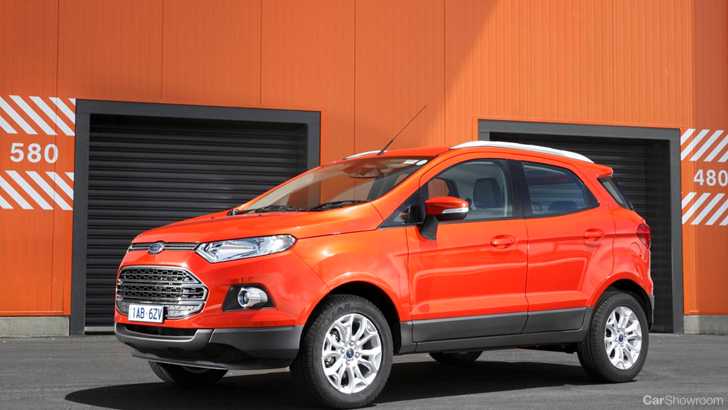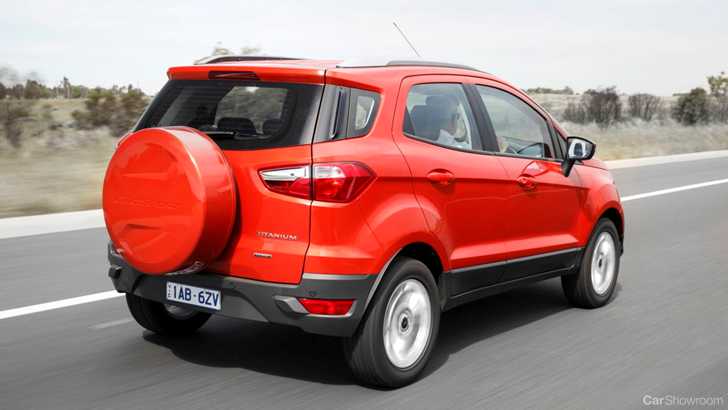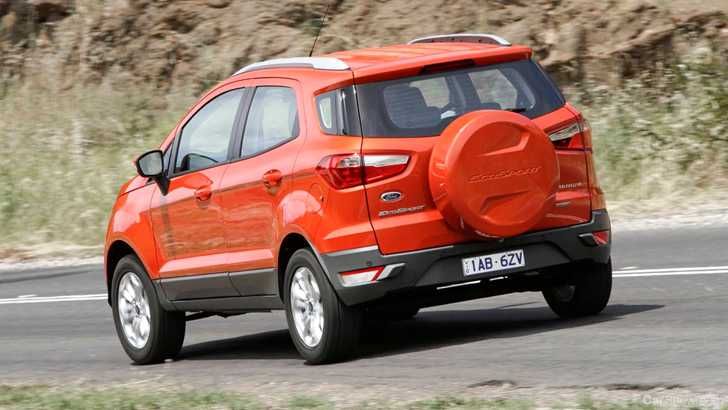Two weeks in two Ford EcoSports confirmed our first impressions – Ford’s new compact SUV deserves the acclaim coming its way from all corners of the globe. Originally created for the South American market, Ford has taken the latest generation EcoSport to the world to get some ‘skin’ in the burgeoning compact SUV game.
Smart move because the EcoSport boasts impressive technology – including the remarkable, fuel miserly turbocharged 1.0-litre three-cylinder EcoBoost petrol engine – which ramps-up the value-for-money equation and highlights why Ford is at the top of its game these days. It helps too that the EcoSport is a modern good-looker with plenty of room inside and the sort of practicality demanded by family buyers.
In fact, combine that practicality with low running costs (5.7l/100kms fuel consumption for the 1.0-litre engine) and a starting price of just $20,790, commercial fleet operators are well advised to consider the Ford EcoSport for their ‘road warriors’.
Ford EcoSport Overview
Ford has launched the EcoSport in the familiar model range – entry-level Ambiente (from $20,790), mid-grade Trend and range-topping Titanium. All are available with either a five-speed manual transmission or a six-speed sequential automatic however the technically-fascinating turbocharged 1.0-litre, three-cylinder engine is only available with a five-speed manual in either Trend or Titanium grades.
CarShowroom.com.au tested the Trend model 1.0-litre ($22,290) and the range-topping Titanium 1.5-litre, four-cylinder automatic ($27,790).
Titanium models add extra style with items like alloy wheels, leather seats and extra convenience with keyless entry.
Ford EcoSport Engine
Here’s where the EcoSport underscores Ford’s global prowess – the 1.0-litre, three-cylinder engine comes from Romania, the six-speed PowerShift automatic transmission is assembled in Mexico and the 1.5-litre engine is made in Chennai, India (where the EcoSport is manufactured).
The remarkable 1.0-litre, three-cylinder EcoBoost engine runs a turbocharger, variable valve timing and direct fuel injection yet is small enough to fit onto an A4 sheet of paper (or can be stowed in an overhead locker in an airplane!). A winner of the ‘International Engine Of The Year’ award and the subject of some 125 global patents, Ford says this staggering little engine delivers performance akin to a 1.6-litre engine but with fuel consumption around 20 per-cent lower.
Maximum power is 92kW at 6000rpm and, with a flat torque curve, pulling power is rated at 170Nm from 1400-4500rpm. Combined cycle fuel consumption scores 5.7-l/100kms.
That’s actually more grunt than the Ford EcoSport’s 1.5-litre four-cylinder engine which posts 82kW at 6300rpm, 140Nm at 4400rpm and fuel consumption of 6.5l/100kms.
Ford EcoSport The Interior
Inside, the Ford EcoSport looks smart and is smart, maximizing its practicality with inclusions like a glove-box chiller which can keep up to six beverage cans cool, a 60:40-plit-fold rear seat and when that seat is folded, some 705-litres of cargo space is available – very impressive.
Overall the styling is very much from the Ford family with a European-inspired layout and nice tactile features throughout. Rake/reach adjustment for the steering wheel provides a nice driving position although the front seats are a tad smaller than some rivals.
As well as leather seats and a leather-wrapped steering wheel, amongst its extras, the Ford EcoSport Titanium adds rear parking sensors and an upgraded multi-function display - which shows where the obstacles are when reversing - and an electrochromatic rear vision mirror (automatically dims when lights from behind are detected).
Audio is a CD/MP3 system with a 3.5-inch display screen and the usual connectivity. But a big plus in Ford EcoSport is Ford SYNC, the system developed by Microsoft with voice command and steering wheel buttons for audio and phone controls.
Ford EcoSport Exterior & Styling
When you have a global array of SUVs which include the European Kuga, the Australian Territory and American hot-sellers like the Explorer, Expedition and Lincoln Navigator, it makes sense for the smallest member of the Ford family – the EcoSport – to borrow some design cues. So, despite its diminutive size, the EcoSport runs a muscly front-end, inspired by its larger siblings.
Side profile sees blacked-out B-pillars to give the impression of a larger glasshouse. We do prefer the look of the 16-inch alloys on our Titanium model test car to the 15-inch steel wheels of the entry-level Ambiente (the bigger wheels fill the wheelarches better).
Other differences according to model are the grilles and roof rails.
The rear view is highlighted by the externally-mounted spare wheel. This frees-up cargo space while providing a full-size spare wheel (for some reason many Australian buyers are wary of ‘space-saver’ spare wheels or tyre inflation kits).
Ford EcoSport On The Road
Underneath the Ford EcoSport runs a McPherson strut front end and twist-beam rear and the platform is a modified version of the one used for the Fiesta compact car. And, perhaps showing its South American market requirements, the EcoSport rides high (200mm ground clearance) and provides other SUV-like stats such as a wading depth of 550mm, an approach angle of 25-degrees, ramp-over angle of 25-degrees and a departure angle of 35-degrees.
It did rain a lot during our two weeks in our Ford EcoSports – but thankfully not enough to test those measurements.
What the autumn downpours did confirm was the EcoSport’s excellent dynamics (no surprise as the Fiesta gives a good account of itself in the twisty stuff). Good noise isolation and suspension calibration meant for refined operations at all speeds and we liked the steering response.
Now about those engines…
We’re in love with Ford’s turbocharged 1.0-litre three-cylinder EcoBoost. Mated to the slick-shifting five-speed manual transmission, this high-tech, fuel-miserly technical masterpiece gets the job done very impressively. Ford has used engineering wizardry to overcome the normal imbalance of three-cylinder engines but the hallmark exhaust growl (a pleasing exhaust note) under acceleration lets you know the ‘International Engine Of The Year’ is at work.
Acceleration was brisk and during our week behind the wheel, the fuel gauge hardly moved from ‘F’ – very, very impressive.
Not that the 1.5-litre four-cylinder is a slouch; it’s quiet and responsive too, but the six-speed auto was a bit too willing to swap ratios when going uphill and we found ourselves changing gears manually a lot of the time.
Ford EcoSport Issues
None of us at CarShowroom.com.au were ever a chance to pack-down in the front row for the Australian Wallabies rugby union team but even we found the front seats in the Ford EcoSport to be a tad too small.
And all SUVs should have as standard reversing camera but the EcoSport more so due to the externally-mounted spare wheel.
Ford EcoSport Verdict
We didn’t get the chance to drive the Ford EcoSport at the international media preview in Goa, India nor see the assembly plant in Chennai but we drove several models at the Australian launch and now these two examples and every one has exuded nice build quality and interior materials and been free of squeaks/rattles. International product sourcing is the way of the Australian market now and of course there’s more to come – especially from Ford, Holden and Toyota.
So, as the company’s entrant to the rapidly-growing global compact SUV segment, you’d expect Ford to play a strong hand and with the EcoSport the ‘Blue Oval’ certainly has.
The trump card is that superb turbocharged 1.0-litre three-cylinder engine and its hybrid-like fuel consumption.
But there’s much more to the Ford EcoSport, punctuated by its good looks, handy interior and value-for-money.
Put this one of your shopping list.
Ford EcoSport The Competition
We’re in Australia so it’s Ford V Holden right? In this case the Ford EcoSport squares-off against the Holden Trax. A 1.8-litre engine with 103kW/175Nm is a plus for the Trax but fuel consumption in the range of 7.0l/100kms to 7.6l/100kms isn’t. Starting price of $23,490 is also questionable now the Ford EcoSport is here from $20,790.
Mitsubishi’s ASX is priced from $24,990 which is a lot in this league. Good as the 110kW/197Nm 2.0-litre engine is, there’s no getting around the fact the 1335kgs ASX is heavy and not very fuel efficient (7.6l/100kms).
We like the Nissan Juke a lot. And we ‘get’ its looks…but many don’t. Most Jukes are powered by Nissan’s 86kW158Nm 1.6-litre engine which is good – however the $21,990 starting price isn’t good when compared to the EcoSport. British-design is excellent, as is the build quality.























